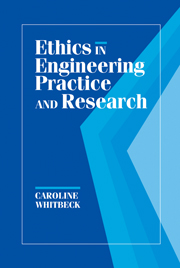Book contents
- Frontmatter
- Contents
- Preface
- Foreword
- INTRODUCTION TO ETHICAL CONCEPTS
- 1 ETHICS AS DESIGN: DOING JUSTICE TO ETHICAL PROBLEMS
- 2 THE BASIS AND SCOPE OF PROFESSIONAL RESPONSIBILITY
- 3 CENTRAL PROFESSIONAL RESPONSIBILITIES OF ENGINEERS
- 4 TWO MODELS OF PROFESSIONAL BEHAVIOR: ROGER BOISJOLY AND THE CHALLENGER, WILLIAM LEMESSURIER'S FIFTY-NINE STORY CRISIS
- 5 WORKPLACE RIGHTS AND RESPONSIBILITIES
- 6 RESPONSIBILITY FOR RESEARCH INTEGRITY
- 7 THE RESPONSIBILITY OF INVESTIGATORS FOR EXPERIMENTAL SUBJECTS
- 8 RESPONSIBILITY FOR THE ENVIRONMENT
- 9 FAIR CREDIT IN RESEARCH AND PUBLICATION
- 10 CREDIT AND INTELLECTUAL PROPERTY IN ENGINEERING PRACTICE
- EPILOG: MAKING A LIFE IN ENGINEERING AND SCIENCE
- Bibliography and References
- Index
3 - CENTRAL PROFESSIONAL RESPONSIBILITIES OF ENGINEERS
Published online by Cambridge University Press: 05 June 2012
- Frontmatter
- Contents
- Preface
- Foreword
- INTRODUCTION TO ETHICAL CONCEPTS
- 1 ETHICS AS DESIGN: DOING JUSTICE TO ETHICAL PROBLEMS
- 2 THE BASIS AND SCOPE OF PROFESSIONAL RESPONSIBILITY
- 3 CENTRAL PROFESSIONAL RESPONSIBILITIES OF ENGINEERS
- 4 TWO MODELS OF PROFESSIONAL BEHAVIOR: ROGER BOISJOLY AND THE CHALLENGER, WILLIAM LEMESSURIER'S FIFTY-NINE STORY CRISIS
- 5 WORKPLACE RIGHTS AND RESPONSIBILITIES
- 6 RESPONSIBILITY FOR RESEARCH INTEGRITY
- 7 THE RESPONSIBILITY OF INVESTIGATORS FOR EXPERIMENTAL SUBJECTS
- 8 RESPONSIBILITY FOR THE ENVIRONMENT
- 9 FAIR CREDIT IN RESEARCH AND PUBLICATION
- 10 CREDIT AND INTELLECTUAL PROPERTY IN ENGINEERING PRACTICE
- EPILOG: MAKING A LIFE IN ENGINEERING AND SCIENCE
- Bibliography and References
- Index
Summary
The body of knowledge that characterizes a profession enables its practitioners to foresee possibilities, to devise ways to achieve desirable results, and to avoid undesirable side effects. Specialized knowledge enables engineers and scientists to design interventions, devices, processes, or constructions and to foresee how those products, processes, and constructions will act or interact. The designers of these products are uniquely qualified to foresee and modify many consequences of their use or misuse. Prominent among such consequences are safety hazards.
HOW CRITERIA FOR PROFESSIONAL CONDUCT CHANGE
Expectations of responsible professions vary not only with profession but also with the profession's experience of accidents and failure. Henry Petroski, in his elegant book, To Engineer is Human, uses examples from civil engineering to richly illustrate his thesis that engineering commonly advances by learning from failure. In almost every case the failures Petroski discusses threatened human health and safety.
Roland Schinzinger and Michael Martin, noting the extensive and often unpredictable character of the influence of technology on human life (not only health and safety), have argued that technological innovation amounts to social experimentation. In recent decades, informed consent has emerged as the primary criterion for ethically acceptable use of experimental treatments on human subjects. Schinzinger and Martin have suggested adapting a similar standard for the adoption of new technology.
Schinzinger and Martin propose using “proxy groups” composed of people similar to those who will be greatly affected by new technology.
- Type
- Chapter
- Information
- Ethics in Engineering Practice and Research , pp. 108 - 132Publisher: Cambridge University PressPrint publication year: 1998



